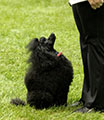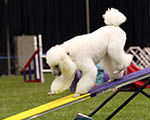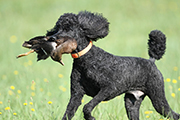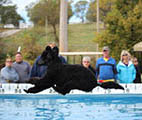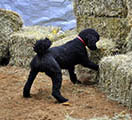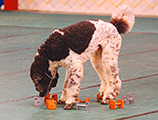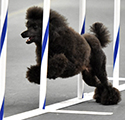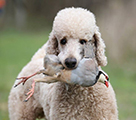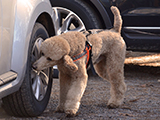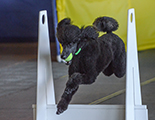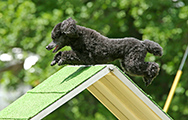Fact Sheet
The Brood Bitch
To improve the overall health of a brood bitch in order that she might whelp naturally and easily and care for her puppies in a manner that will increase puppy survivability and health.
A bitch being considered for a breeding program should be structurally correct (no major faults) according to the Illustrated Breed Standard found at: http://www.poodleclubofamerica.org/breedstandard.htm. She should have a superior temperament (no shyness or aggression and should be self-confident, playful and love children and other dogs). A bitch should be in excellent physical condition (well-muscled and in proper weight) to enable her to whelp naturally and easily. A bitch who is overweight or underweight, or one who lacks muscle, may have complications during delivery.
She should have been tested for genetic health disorders appropriate for the variety and she should have passed the tests (see CHIC information at http://www.caninehealthinfo.org/breeds.html).
A bitch that tests positive for any genetic heath disorder should not normally be used in a breeding program, but there may be exceptions. Correctly using a DNA test for a disorder caused by a recessive mutation allows an affected or carrier mate to be used with a mate that tests normal thus ensuring that the breeding will not produce affected offspring. The offspring would then be used appropriately after testing. This is sometimes done to prevent loss of genetic diversity.
Recommendations are different for polygenic diseases such as Addison’s Disease and hip dysplasia. Dr. Jerold Bell writes about polygenic disease in the following article, entitled Managing Polygenic Disease, and he uses hip dysplasia as an example:
https://www.vin.com/apputil/content/defaultadv1.aspx?meta=&pId=11165&id=3848681
Applying Dr Bell’s breeding advice to Addison’s Disease, breeders can follow the same strategy they employ to avoid hip dysplasia and thereby improve their risks:
- Affected dogs should not be bred.
- A dog with close and/or multiple Addisonian relatives should not be bred to another with similar risks.
- The only reason to use a dog with close Addisonian relatives would be to protect genetic diversity, and only with exceptional quality. High risk dogs should be bred sparingly and only to those with very few Addisonian relatives in their lines.
- If there are lower risk offspring or parents of the same quality, then producers and offspring of Addisonian should be not be bred, but replaced with the lower risk dogs in the breeding program.
- In addition to numbers of related Addisonian dogs, breeders should consider each affected dog’s age of onset, severity of onset and any extreme environmental exposure to determine different levels of risk when assessing depth and breadth of pedigree.
Ideally, a bitch should not be bred more often than every other heat. However, in some instances (i.e., age, availability of the stud dog, etc.) it may be appropriate to breed a bitch on two consecutive heats. A bitch under two years of age is not mentally or physically mature enough to be bred. Bitches over 7 years old may have age-related complications during whelping. A bitch should not have more than 3 or 4 litters in her lifetime.
Careful consideration should go into the choice of the stud dog. He should be structurally correct (no major faults) according to the breed standard. He should have a superior temperament (no shyness or aggression) and should have been tested for genetic health disorders as noted above for the bitch. You should exchange copies of test results with the stud dog owner or check testing results on the Orthopedic Foundation for Animals site at http://www.ofa.org/. The choice of a stud dog should be based on compatible pedigrees rather than flashy advertising and pretty pictures. Current information suggests that using DNA testing to help increase Diversity, especially in the standard poodle population, will also decrease incidence of autoimmune disease. Information regarding the Poodle Diversity Project may be found at:
- http://poodlesdegrenier.com/poodle-diversity-project
- https://www.vgl.ucdavis.edu/services/dog/GeneticDiversityInStandardPoodles.php
- http://poodlediversity.com/
It can take time to pick the right dog, so you should not wait until your bitch is due to come into season before choosing a stud dog.
Many breeders who use a stud dog that is not local for natural cover breeding now utilize fresh chilled or frozen semen which can be shipped by overnight delivery to a theriogenologist (a veterinarian who specializes in canine reproduction) for artificial insemination. You should contact your veterinarian and plan for this well in advance of the time so that necessary supplies have been ordered. If this method is not available, it may be necessary to ship your bitch to the stud dog. Make sure that she is freshly bathed and in a clean crate with clean bedding. Advise the stud dog owner of her specific diet to limit the stress of changing foods. Clearly mark the crate with her name, your name and where she is going. Include your cell phone number. It is also a good idea to use a tear-away ID collar with her name, your name and phone contact information and include the stud dog owner’s name and phone contacts. You must follow the airline instructions regarding sending your bitch.
A bitch that is going to be bred should be brought up to date on all vaccinations well in advance of being bred or have demonstrated adequate antibody titers to the recommended diseases.
Internal and external parasites will prevent a bitch from providing maximum nutrition and immunity to her puppies. This puts the puppies’ survival at risk. If the bitch has fleas, use a safe product to eliminate all external parasites. Consult your veterinarian for advice about testing for internal parasites and if necessary de-worming the bitch several weeks before she whelps.
Both the bitch and stud dog should be tested for brucellosis (a highly-contagious disease) prior to breeding. Infected dogs shed Brucella organisms in all body fluids, including urine, saliva, semen, vulvar discharge, and milk. Transmission occurs through ingestation or inhalation of infectious organisms. Dogs that have not been bred may still have been exposed by eating infectious organisms off the ground. Animals that have been diagnosed should be considered carriers for the rest of their lives. Bitches carrying the brucellosis bacteria will often abort their litters; if puppies are born live, they will do poorly and generally die well before weaning.
It is also possible for this disease to be transmitted to humans through contact of the infected dog’s bodily fluids or by handling aborted fetuses.
From the CDC website:
Brucella canis is a bacterium that causes brucellosis in dogs. It can also cause infection in humans. Typically, there is a low risk of infection for pet owners.
Dog breeders and veterinary staff, however, face an increased risk since they may be exposed to blood, tissues, and fluids associated with the birthing process.
Laboratory staff exposed to Brucella canis (or any other Brucella species) should follow CDC recommendations for exposure in a laboratory setting.
Currently, there are no serological tests to detect antibodies to Brucella canis. Therefore, more attention should be given to symptom monitoring.
Pet owners who feel that they may have been exposed should contact their local or state health departments for guidance.
Immunocompromised persons (cancer patients, HIV-infected individuals, or transplantation patients) should not handle dogs known to be infected with B. Canis
A whelping box appropriate for the size of the bitch should be provided in a warm, draft-free room. The box should have a ledge that prevents the bitch from lying on puppies that get between the bitch and the side of the box. The bottom of the box should be lined with absorbent material such as old blankets, terry towels, indoor/outdoor carpeting, or artificial lamb-skin materials that can be removed and washed several times each day. These materials also provide good traction for puppies moving about the box. Slippery materials should not be used. You may also want to provide a source of artificial heat such as an electric heating pad or heat lamp under one corner of the whelping box as a warming area that the puppies can crawl on or off as they want, to regulate their warmth. There are many commercial whelping boxes or pens available.
The information contained in these documents is current at the time of this writing and is accurate to the best of VIP’s knowledge.
This information has been provided to you at no charge. You are free to use it provided it is used in its entirety with no changes or alterations and that the copyright remains intact. If you have found this information to be helpful, please consider making a tax-deductible donation to:
Versatility in Poodles
4061 Highlands Rd
Franklin, NC 28734
To make a donation via PayPal, please click the Donate Button:
The contents of the www.vipoodle.org website, such as text, graphics, images, and other material contained on this site (“Content”) are for informational purposes only. The Content is not intended to be a substitute for professional veterinarian advice, diagnosis, or treatment. Always seek the advice of your veterinarian with any questions you may have regarding the medical condition of your pet. Never disregard professional advice or delay in seeking it because of something you have read on this website!
If you think your pet has a medical emergency, call or visit your veterinarian or your local veterinary emergency hospital immediately. Versatility in Poodles and www.vipoodle.org do not recommend or endorse any specific veterinarians, products, procedures, opinions, or other information that may be mentioned on this website. Reliance on any information appearing on this website is entirely at your own risk.


